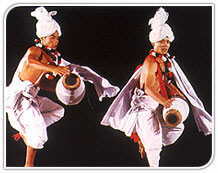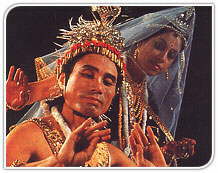Dances of India: Manipuri
 The
Manipuris have song and dance woven into their life and regard themselves
as the descendents of gandharvas. Their love for dance.
The
Manipuris have song and dance woven into their life and regard themselves
as the descendents of gandharvas. Their love for dance.
Their
love for reflects their rich lore of legend and mythology There is no
authoritative record of the history of Manipur's dance and music prior to
the 18th Century A.D.
However, the lasting developments in
technique and methods took place during the time of Jai Singh (1764 to
1789), who was a great devotee of Lord Krishna and a follower of
Vaishnavism.
Among the legendary and mythological tales, the
Rasa Lila, dance performed by Shiva and Parvati and Lai Haraoba, of Khamba
and Thoibi the celebrated lovers, deserves special mention.
 In
the Rosa Lila, the movements are extremely graceful coupled with soft and
light steps in which the heels never touch down. The dancers have a fixed,
angelic expression on the face.
In
the Rosa Lila, the movements are extremely graceful coupled with soft and
light steps in which the heels never touch down. The dancers have a fixed,
angelic expression on the face.
The costume is extremely
colourful and glittering. Lai Haraoba is the oldest dance form of Manipur
and belongs to the pre-Vaishnava period. The dance style is diffused and
meandering.
The dancers make stylized hand and body movements,
but the face remains blank. The steps are gentle yet powerful.
Even
today, dancing remains a key element in the art and ritual of daily life
in Manipur. Where the genius of Tansen st at sadhana.
Symbolizing
the endeavor of the individual artist and the fusion of two cultures-
Hindu and Muslim to enrich Indian Art.  The
Manipuris have song and dance woven into their life and regard themselves
as the descendents of gandharvas. Their love for dance.
The
Manipuris have song and dance woven into their life and regard themselves
as the descendents of gandharvas. Their love for dance.  In
the Rosa Lila, the movements are extremely graceful coupled with soft and
light steps in which the heels never touch down. The dancers have a fixed,
angelic expression on the face.
In
the Rosa Lila, the movements are extremely graceful coupled with soft and
light steps in which the heels never touch down. The dancers have a fixed,
angelic expression on the face.